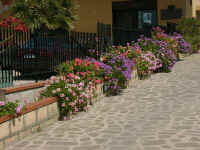|
Page 1 2 3 4 5 6 7 8 9 10 11 12 13 14 15 16 17 Tuesday, April 10. We put our luggage out at 8:00, had breakfast, and were on the bus at 9:00. It was a pleasant, sunny day for our drive to Agrigento on the southern coast. Enzo stuck to main roads (the autostada almost to Enna, then the highway to Agrigento), so we made good time. The countryside was surprisingly green, but Oliviero explained that it would turn brown soon enough once the hot, dry summer weather arrived. The prickly pear cactus grew profusely throughout the countryside. We saw many wheat fields on the hillsides, and there were great quantities of a red clover we had never encountered before.The bus reached the Grand Hotel dei Templi in Agrigento after 11:30 a.m. After checking in, we had about an hour free before lunch, so we walked along the main road looking in some of the shops. They weren't very interesting, though. We had lunch at our hotel at 1:00. The dessert, according to Oliviero, at least, was "the best ice cream in the world." Afterwards the bus took us the short distance (about two miles) to the famous Valley of the Temples. Despite the name, most of the temples are actually on top of a steep hill, some of them silhouetted against the sky. Agrigento was founded by the Greeks in the 6th century B.C. It was destroyed and rebuilt several times over the next two centuries. The Valley of the Temples dates mostly from the 5th century B.C., roughly the same time that the Parthenon was built (438 B.C.). From ancient records, it is known that there were 21 temples on the site, but only ten have so far been found. That is more temples at a single site than anywhere else. Unfortunately, most of them are in ruins, with pieces strewn about or missing. Besides the ruins of the temples, there are remains of the city wall, a necropolis, houses and streets. Our first stop was at the Temple of Hera (Juno) (c. 450 B.C.), which has 25 of its original 34 columns in place. Its style has been compared to that of the temples at Paestum. As we moved on, we stopped by a section of the city wall. It had been carved out of a natural stone formation. Next we came to the Temple of Concord (c. 440 B.C.). With all 34 of its columns and even part of the cell intact, it's in the best condition of any of the temples in the Valley by far. That is because it was converted into a Christian basilica around the 7th century. Nearby there's a huge olive tree believed to be almost as old as the temple. Our guide explained that this temple, and the others here, weren't built of marble like those on the Acropolis. Rather they were sandstone, covered with a stucco made with marble dust so they appeared to be solid marble. As we moved on, we passed a large Christian necropolis (cemetery), dating from Byzantine days. Just past that we came upon the largest Sicilian cart we had seen. A little further on we passed the Temple of Heracles (Hercules), the oldest temple in the Valley (6th century B.C.). Only eight of the columns were standing. Finally we came to what had been the Temple of Olympic Zeus (Jupiter), once the third-largest Greek temple in the world [the only larger ones being in Epheses (Turkey) and Selinunte (Sicily), not in Greece]. It's foundation measures 370 feet by 185 feet. It was unusual in that it wasn't surrounded by columns, but had solid outer walls, with half columns (60 feet tall) for decoration. It was destroyed by an earthquake. Pretty much all that remains now is a pile of rubble. A number of telamons (large segmented stone columns in the form of human figures) have survived, though. There was one reassembled lying on the ground (actually a replica). It is 25 feet high and, since it had stood nearly 60 feet above the ground, was designed so it seemed to be in proper proportions only when viewed from below.
The guide pointed out to us the ruins of a few more temples that are not on the tourist circuit because so little of them has been found. Then we walked back to the bus for the short drive back to out hotel. We got there about 5:00 and had an espresso in the bar before going to our room. At 7:30 we has an excellent fish dinner in the hotel restaurant. We finished just in time for the big surprise Oliviero had promised us. We boarded the bus at 9:00 p.m. and headed back toward the Valley of the Temples. Enzo turned off the lights inside the bus and put on some inspirational music as the temples came into view. They were illuminated now and breath-taking in their beauty. He drove very slowly, twice back and forth so we passed the temples four times. It only took half an hour altogether, but it was one of the highlights of the trip. Afterwards we had to return to the mundane task of packing. Page 1 2 3 4 5 6 7 8 9 10 11 12 13 14 15 16 17
Copyright © 2000-2023 DarrellPeck.com All rights
reserved. | |||
















